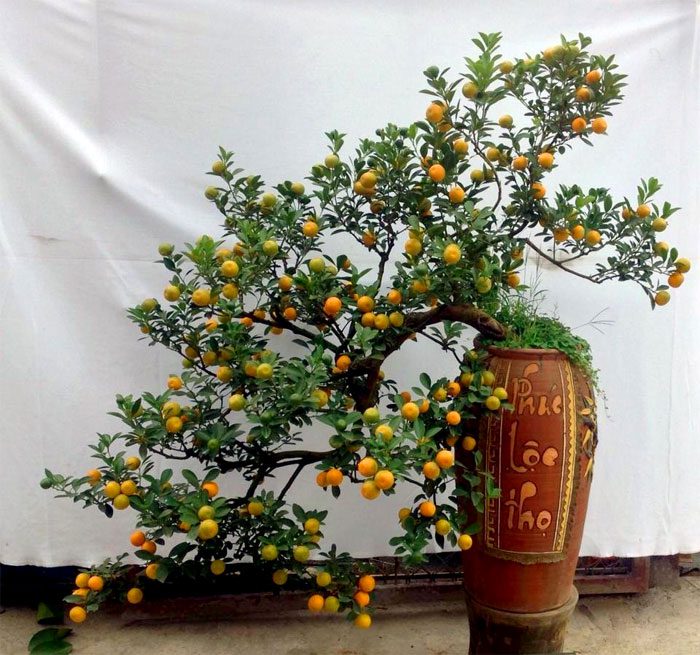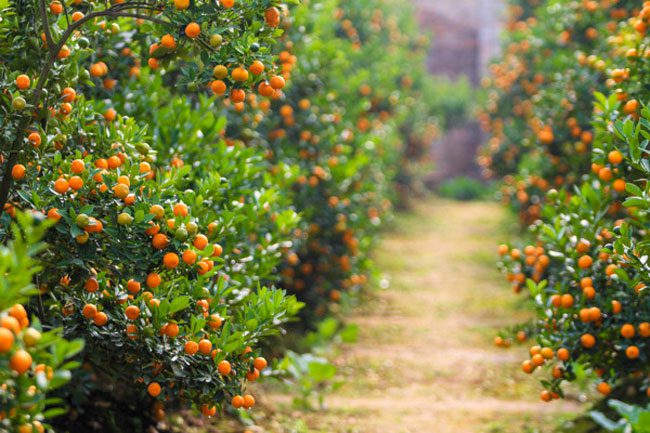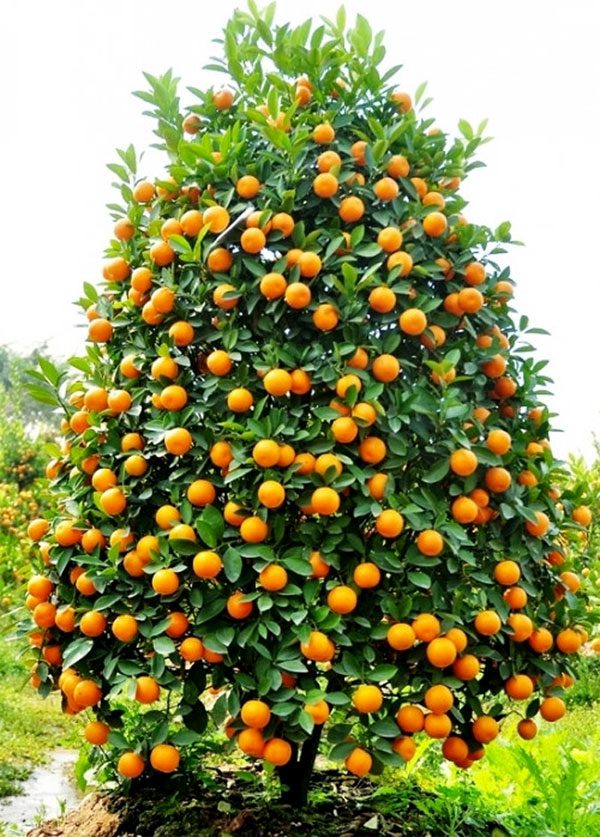In addition to the golden apricot, the branches of kumquat laden with fruit are also a beautiful sight for the Lunar New Year. To ensure that the kumquat tree produces many plump, juicy fruits each year, it’s essential to master the care techniques for kumquat trees after Tet. Follow this article to learn the essential tips for caring for potted kumquat trees after Tet so that they bear fruit abundantly next year!
Guide to Caring for Ornamental Kumquat Trees After Tet
However, when summer arrives, the kumquat fruits are no longer present, and the tree is no longer suitable for display. Should you discard the tree or replant it for the following Spring?
Many families are beginning to pay attention to how to care for their kumquat trees at home after Tet, as maintaining the tree not only brings joy but also saves money for next year’s Tet celebrations, eliminating the need to buy a new tree.
Many people want to utilize their kumquat trees but lack the necessary techniques. Therefore, follow this article to learn simple ways to care for kumquat trees after Tet at home!
Caring for Kumquats During Tet
Each day, use a small spray bottle with a capacity of 0.5-1.5 liters to spray or sprinkle clean water on the leaves 1-2 times, ensuring that the roots receive enough moisture, keeping the leaves fresh and minimizing drop-off during the Tet display.

Caring for Kumquats After Tet
Notes When Replanting Kumquats After Tet
The first factor to ensure that the kumquat tree can be reused after Tet is its overall health. If you have a beautiful, healthy kumquat tree with lush leaves that are not damaged or infested, you can certainly take care of it to promote further growth.
Maintaining moisture for the tree is essential. Use a spray bottle to moisten the tree and potting soil or sprinkle water on the leaves daily. When watering, do so gently at the base of the tree to avoid soil compaction.
The above actions will help ensure that the kumquat tree retains its leaf greenness and minimizes fruit drop during Tet. This way, after the Tet display, we can reuse the tree.
If you plan to replant and fruits are still on the tree, be sure to remove all of them. You should also trim about half of the leaves to reduce the tree’s nutritional and water needs, allowing the roots to develop securely in the new environment.
10 Days Before Replanting
Use a rooting enhancer product to thoroughly wet the leaf canopy and the base of the tree. After 10 days of treatment, the kumquat’s root system will be activated, and new roots will form. Trim 1/2 to 2/3 of the leaves and then proceed to replant, watering them as you would with regular kumquat seedlings.
Kumquats are typically planted in garden soil mixed with sand and clay to ensure good aeration and adequate moisture. The suitable soil pH for planting kumquats is 5-6.
For planting holes, add 1-2 kg of microbial fertilizer or 3-5 kg of decomposed manure as a base. The planting soil should be mounded high, with water ditches surrounding it, mounds should be 4 – 6 meters wide, and ditches should be about 20 – 30 cm deep, preventing waterlogging, which could halt the growth of kumquats and may even kill them.

Care Instructions
Around 5-7 days after planting, the grower should loosen the soil around the base (about 30 cm away) to aerate it and apply or fertilize (0.5-1 kg of NPK (12:5:10) per base, 30 cm away) to promote rapid growth of branches and leaves. You can also provide additional water or decomposed manure to ensure the kumquat tree is healthy and reduces pests and diseases.
Use organic micronutrient fertilizer PTS9 as a substitute for manure combined with ecological growth enhancers sprayed intermittently (5 ml/15 liters of water when young leaves are abundant and 5 ml/10 liters of water when leaves are mature) about every 15-20 days for thick, green leaves, large fruits that ripen beautifully and drop less, and for the tree to resist pests and diseases effectively.
Pest and Disease Control
Seasonal diseases, especially in humid weather, can make kumquat trees susceptible to harmful fungi. Additionally, aphids may attack the stems, leaves, and roots. Therefore, when watering the tree daily, observe the entire plant to quickly identify and address any pest issues.
If you plan to use the kumquat tree for purposes other than ornamental display, such as using the leaves for herbal baths for children or consuming the fruits, do not spray pesticides on the plant, as they could pose health risks. It’s best to use gardening tools to manually remove pests. For fungal infections, diluted lime water or saltwater can be used to wash the leaves and fertilize the base of the tree.
Shaping and Pruning
You can create new shapes or maintain those established from the previous year. The person shaping and pruning should study relevant materials and practical production to grasp the basic shapes of each style to achieve success.

When pruning, ensure you use sharp, specialized tools and perform the task on sunny days. Shaping should be done regularly every 7-10 days.
Developing Fruit and Foliage for Year-End
Kumquats should be replanted in the middle to late May. Before replanting, ensure the soil is sufficiently moist and use a metal or wooden post to compact the soil around the base (about 20-30 cm away) to prevent cracking or breaking the root ball during digging.
The size of the root ball depends on the tree, the diameter of the canopy, and the size of the pot intended for replanting. Begin by digging around 60-100 cm from the base, creating a trench 40 cm deep and 20 cm wide. Trim the soil to the desired root ball size, and during this process, remove any excessively large roots (greater than 1 cm in diameter) that cannot wrap around the ball, while smaller, softer roots should be wrapped around the ball and tightly bound with nylon string.

If you plan to have the canopy produce only ripe fruits, do the following: Place the tree, after repotting, in a shaded area to avoid heavy rain damaging the root ball. After 10-20 days, when about 80-90% of the leaves have wilted and fallen, replant and care for it normally. The tree will bloom and bear fruit simultaneously in July-August, ripening in January-February for the Lunar New Year.
If you want a canopy with both ripe and green fruits, as well as flowering foliage, after repotting, keep the kumquat in a shaded spot for 7-10 days so that the tree loses about half of its leaves, then replant. When the tree bears fruit from the first and second flower batches (June-August), thin out half of the fruit, cut back the young shoots, and remove half of the mature leaves while applying nitrogen + potassium fertilizer or ecological growth enhancers to stimulate further flowering and fruiting. By year-end, the tree will have a canopy full of ripe fruits, green fruits, flowers, and new foliage as desired.
Frequently Asked Questions About Caring for Kumquat Trees After Tet
How Many Times Does a Kumquat Tree Bear Fruit in a Year?
Kumquat trees bear fruit year-round. Therefore, if you want the tree to bear fruit and ripen just in time for Tet, you must employ the correct care techniques.
How to Have Both Green and Ripe Kumquats?
Every 5 to 7 days, you should loosen the soil about 30 cm from the base to aerate it, and apply around 0.5 – 1 kg of NPK fertilizer per base. You can use organic fertilizer PTS9 instead of manure. Additionally, combine this with growth enhancers (every 15-20 days) to ensure that the tree has both green and ripe fruits.
What is the Best Way to Prune Kumquat Trees After Tet?
Every 10-15 days, it’s advisable to trim leaves, cut branches, or shape the branches once.
Pruning also helps the tree receive more sunlight, concentrate nutrients, and stimulates more leaf growth, more flowers, and more fruiting for the next Tet.
How to Care for Kumquat Trees to Bear Fruit Just in Time for Tet?
For the tree to bear only ripe fruit: Place the tree in a shaded area after it has been repotted. Within 10 to 20 days, when 80 to 90% of the leaves have withered and fallen, replant the tree and care for it as usual. The kumquat will bloom, bear fruit, and ripen simultaneously for the Lunar New Year. For the tree to have both ripe and green fruits along with new blossoms: After repotting, place the tree in the shade for 7 to 10 days and allow it to shed about half of its leaves before replanting. When the tree bears fruit from the first two flowering cycles, remove half of the fruit, prune the young shoots, remove half of the medium-sized leaves, and apply nitrogen and potassium fertilizer. The tree will continue to bloom, bear fruit, and produce new growth in time for Tet.


















































